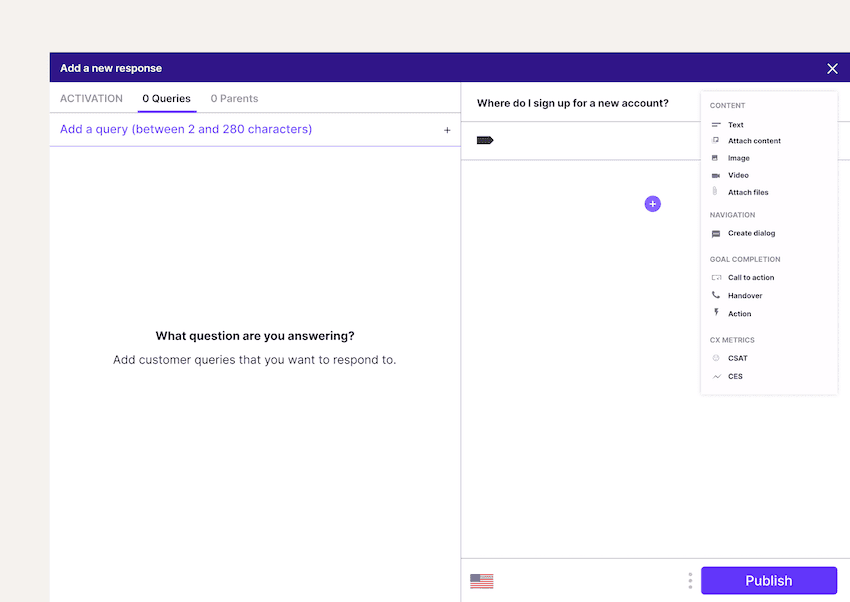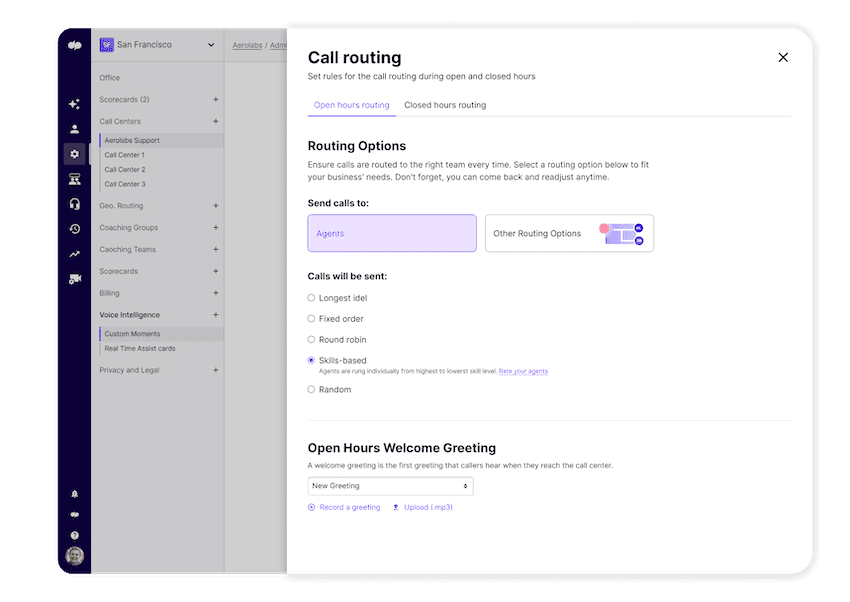
Tags
Share
In nearly every piece of science fiction, there are scenes where characters talk with artificial intelligence. Whether it’s asking HAL 9000 to open the pod bay doors, Deep Thought determining the answer to the question of life, the universe, and everything, or C-3PO introducing himself as an expert in “human-cyborg relations,” talking to machines just feels normal in those worlds.
And guess what? It’s normal in today’s world too, just not in the way that you might expect.
Conversational AI, or conversational artificial intelligence, has become a key part of the business world, particularly in contact centers that are using automation to work more efficiently and provide a better customer experience. Whether through chat bots, interactive agents, or voice menus, conversational AI is essential for customer support today, helping customers and agents alike.
So how are we using this amazing technology? Let’s take a look at some examples of conversational AI and how it can be used in businesses.
3 types of conversational AI
To begin, there’s one key question we must answer: what is conversational AI? We can break it down to a few examples of AI in business environments:
1. AI-powered chatbots
Yes, chatbots are the first (and perhaps most common) form of conversational AI. You may have had bad user experiences with chatbots through social media channels like Facebook Messenger, WhatsApp, and Google Assistant.
Typically, these bad experiences would’ve had no conversational flow at all, mainly because they’re just very basic chatbots that react to different messaging prompts and your selection of predetermined answers. Maybe they just gave you a link to the Help Center and said “our agents are unavailable right now.” (And yes, that example comes from personal experience.)
But chatbot technology has grown past that point, and they can actually be good, helpful tools that use natural language understanding (NLU) and natural language generation (NLG) to interact with people using more human language.
AI chatbots make it easy to answer basic questions, look up information, and assist customers without them even needing to speak to an agent. And it can all be done from a little pop-up window on a company’s website. With Dialpad's contact center platform, for instance, you can build one of these chatbot flows in minutes with the no-code drag-and-drop builder:

2. Voice assistants
Is there a phone equivalent of an AI bot? Yes, and it’s called a voice assistant.
Voice assistants recognize voice commands and turn them into text entries for the AI, so that they can perform similar functions to AI chatbots. Think of them like Google Home, Amazon’s Alexa or Apple’s Siri—they understand your speech, recognize your request, and perform an action based on it.
Think of voice assistants as convenient voice interfaces. They can carry out commands and reply to queries, making them helpful tools for looking up information or performing basic tasks.
3. Interactive voice assistants (IVA)
Going one step beyond voice assistants, we have interactive voice assistants (IVA) or virtual assistants. They take the convenience and functionality of voice assistants, but add in a level of conversational interactivity.
Interactive voice assistants are there when your contact center agents are busy, answering each call immediately to help customers as soon as they call in. They use natural language processing (NLP) and natural language understanding (NLU) to provide a proper conversation, or identify a caller’s concern and direct them to the right agent.
As with AI chatbots, interactive voice assistants are great for helping customers resolve issues without even needing to speak with an agent. They can answer questions, look up information, and provide assistance to customers, saving callers time and reducing agents’ workloads.
📚 Further reading:
Learn more about NLP in customer service.
Conversational AI applications and examples in business
While AI isn’t quite at the point of being able to go out and grab your company’s executives a coffee (or even “tea, earl grey, hot”), it is an amazing tool for customer service. Here are just a few use cases for how businesses can use conversational AI platforms or apps today.
1. Book clients for your services
One of the most convenient things you can do with conversational AI is help customers book services. It’s just like scheduling an appointment online, except the AI can walk the customer through it and provide a more personalized service.
Have you ever tried to book an appointment online, only to find that the process has too many steps, and you can’t go back without undoing everything? It’s a lot easier to call in and speak to a person in those cases. But with conversational AI, you don’t even have to speak to a person—you can just message the chatbot, “I’m looking for an appointment, here’s my availability and location” and it’ll help you find the next available appointment quickly.
Take healthcare, for instance. For many healthcare providers, if you want to book an appointment through their website, you have to go to the appointment menu, select your location, see what times are available with which doctors at that location, select one, and confirm the appointment. But if no good times are available at that location, you have to go back and start the whole process again.
Consider, instead, the difference that conversational AI could make here. Instead of going through the menu options, you could just chat with an AI that already knows your location and physician. If none of the available times work for you, you could just say so and it would pull up other locations and availability. You could even describe your symptoms so the AI can recommend a doctor whose specialization is right for your case.
Basically, it combines the convenience of scheduling an appointment online with the flexibility and intelligence of actually talking to someone.
2. Understand customer preferences to give them personalized suggestions
Have you ever seen a mobile ad and thought “my phone is clearly reading my mind?” That’s not telepathy, that’s algorithms determining what you want based on your past activity. For many ecommerce companies, this is one of the biggest advantages of conversational AI.
Imagine if a customer uses your AI chatbot to ask about a type of product. It could just pull up everything that’s similar to the product, or it could provide personalized recommendations based on the customer data and relationship history. The latter is more likely to make a sale and give the customer exactly what they’re looking for, whether it’s a premium service that matches their needs or a feature you know they like.
3. Answer FAQs and resolve general issues (without needing an agent)
One of the most common uses for conversational AI is to answer questions customers may have. These are typically simple for conversational AI to answer, because the information they need is all available and easily searchable in the company’s frequently asked questions.
Similarly, conversational AI can help resolve customer issues without them needing to speak to an agent.
A good AI can walk customers through troubleshooting steps, look up account details, and carry out basic tasks like upgrading subscriptions or editing accounts. If a customer has a billing question, the AI can check out their account and provide a breakdown of their charges. If they need help with an error they’re getting, the AI can give them a step-by-step process to address it.
This helps customers get resolutions more quickly, while freeing up agents for more pressing matters. This is also great for 24/7 self-service customer support, because AI technology can answer questions any time of the day and streamline workflows for agents by taking on those tasks.
4. Connecting callers with the right agent
What happens when a customer has a question that the AI system can’t answer? In that case, conversational AI can also help connect the caller to the agent best equipped to answer it.
The AI can learn what the caller’s concerns are or what questions they need answered, and then find out which agent has the skills and knowledge to resolve their issue.
As an example, think about conversational AI in financial services. A caller could call in with a simple question, like wanting to check their balance; the voice menu alone could help with that. But financial services is more than just banking—what if the caller has questions about specific investments, retirement planning, or insurance? The AI could understand their question, identify the agent with the best skills to help with that topic, and forward the call to that agent. That way every agent gets to provide financial advice for the topic they know the most about, and customers get the best help possible.
For instance, Dialpad Support has options for an interactive voice response (IVR) menu and skills-based call routing. (Plus it works across both a desktop and mobile app.) So callers can reach an interactive voice menu, and if the self-service options can’t answer their question, the call routing can direct them to the agent with the right skills to help them:

👉 Dialpad tip:
Dialpad Ai can help contact centers with skills-based routing, agent availability, and call routing—see how CareRev uses it to reduce missed calls by 90%!
5. Lead generation and increased sales
One great feature of conversational AI is just its ability to engage with people. When a potential customer visits an ecommerce website, an AI chatbot can interact with them, teach them about the product or company, and provide information that can pique their interest.
That customer engagement alone is a great way to start building leads and conversions, since it keeps the customer actively involved during their visit and has them engaging with the website. Since they’re asking the chatbot questions, it means they’re learning about the things they’re interested in, rather than searching the site and digging through pages that might not matter to them.
6. Employee training and development
Conversational AI isn’t just for customers—companies can also use it for employee training. Supervisors can use AI to analyze phone calls for customer sentiment, uncover insights from transcriptions, and provide agents with important information while they’re talking with a customer (like with Dialpad’s Real-Time Assist cards, which pop up during a call whenever Dialpad Ai hears a preset keyword to give agents relevant information):

And even if a manager hasn't had time to create an RTA card, Dialpad's Ai Live Coach feature can still automatically search your company knowledge base and even unstructured sources of data (like PDF documents) to find answers:

👉 Dialpad tip:
Want to see how Dialpad Ai, transcriptions, and Real-Time Assist cards help Rently boost their CSAT scores to 4.5 and above? Learn all about it in their customer story!
Provide a better customer experience with these examples of conversational AI
What’s next for conversational AI? As the technology evolves and AI continues to learn through deep learning, it’ll be able to better understand user intent, provide more appropriate responses to customer queries, and offer more human-like conversational experiences that aren’t just based on rigid rule-based scripts.
Right now AI can resolve a pretty wide range of customer interactions and perform minor tasks. But give it time and development, and it’ll be able to move past that. For instance, providing customers with troubleshooting steps will evolve into being able to diagnose an issue and walk the customer through the process even when things don’t work as expected, highlighting one of the many reasons why AI is good.
This will also extend to speech recognition and analytics. As we continue to use conversational AI chatbots, machine learning enables it to expand its knowledge and improve the accuracy of its automatic speech recognition (ASR). That’ll give us more accurate transcriptions, better understanding of customers’ needs, and new ways to find information for agents.
One thing AI solutions won’t do is replace human interaction altogether. There will always need to be human agents ready to handle more complex cases, or provide that element of human conversation that even AI can’t. But as AI develops to handle a wider variety of queries, it’ll help customers get the help they need more quickly while freeing up agents for the bigger tasks.
These are just a handful of AI in business examples and as conversational AI continues to grow, we’ll keep finding new ways to improve Dialpad Ai for business communications across all industries.
See how Dialpad Ai works
Get a demo of Dialpad Support and see how customer support and sales teams are using the conversational AI functionality. Or, take a self-guided interactive tour of the app on your own first!

